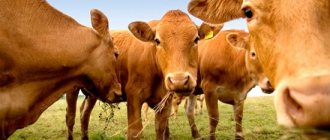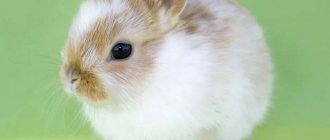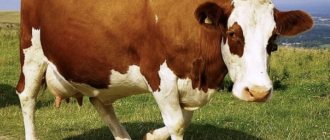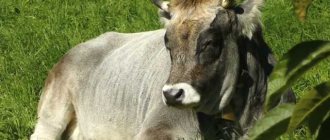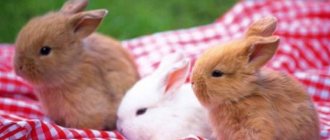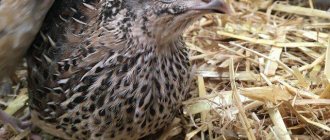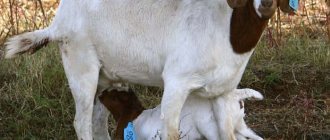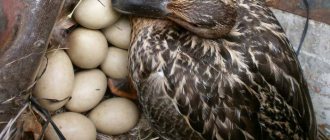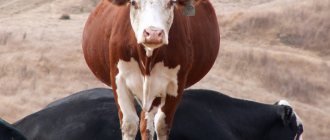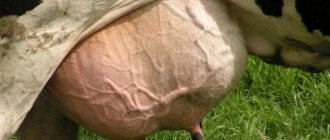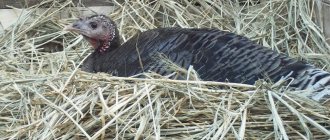Average life expectancy of a cow
The lifespan of cows is influenced by a number of factors, ranging from climate to breed.
However, there are also general statistics that reflect the average lifespan of animals. A cow can live up to 25 years, and with good care and good health even up to 40 years, but less often. In Russia, according to statistics, the lifespan of cows is 20 years. There is an officially registered long-lived cow, Big Bertha, who lived for 49 years, just short of her half-century anniversary. Bulls live less - 15 years.
Strong and healthy cows are those that live in villages located far from large cities, near which the health of animals is undermined due to environmental factors.
If cows were left to live in retirement after cessation of lactation due to age, then, most likely, Big Bertha would not be the only long-liver.
What influences?
Many factors influence the lifespan of a cow. These include climatic conditions, the country in which she lives, and necessarily her diet, as well as caring for the cows. The most comfortable conditions for a domestic cow are to keep it at a certain temperature: within 10°. Otherwise, the animal quickly uses up its natural potential . In addition, they do not tolerate high humidity and drafts. Accordingly, in those places where the vegetation is very poor and the conditions are too harsh, cows live much shorter.
The country in which the cows are raised is also considered an important factor. In some, they are treated with great respect, so there is a chance that they will live to old age without being sent to slaughter. The breed of cow also influences it. After all, if it is meat, then the life expectancy is much shorter, and dairy cows live longer. This also applies to the gender of animals, for example, heifers live longer than bulls.
However, the most important point in raising cows, as well as a factor influencing their life expectancy, is proper feeding. The diet must include:
- special feed that includes all the necessary vitamins and minerals;
- chalk;
- sunflower seed cake for better milk yield;
- fresh meadow hay or straw;
- grated beets.
With the help of these products you can not only extend the life of cows, but also increase milk yield.
These animals are quite receptive to affection and care, so the more attention you give them, the more productive they will be. Good care usually results in them living a little longer. This is especially true for those animals that live on their own farms.
How long do you keep a cow?
Cows have up to 12 calves on their own farmstead. After it, the animal loses its ability to reproduce, which means that after the end of the lactation period, cows will not be able to resume it again. If you breed a heifer for the first time at 2 years old and then get calves from her every year, then the profitable period will be 15 years. After this, only meat is obtained from the cow, to which it is sent.
It is also necessary to take into account the fact that a number of dairy breeds, characterized by particularly high milk yields, live 4 years less, and accordingly become old after the 8th calving. The length of lactation plays a major role in how many years a cow lives.
Signs of old age in animals are:
- Long sleep;
- Decreased appetite;
- Severe tooth wear;
- Reduction in milk volume up to its complete absence.
With these manifestations of old age, the heifer is replaced with a young one. An aged cow is slaughtered for meat or left to live out its life in retirement.
How many years does a cow live?
Man domesticated cows and bulls more than a thousand years ago, and since then has been actively breeding cattle for household or industrial purposes. Nowadays, a cow is no longer able to live in the wild, since it has completely become a domestic animal . The lifespan of a cow or bull is influenced by the degree of care for the animal, nutritional conditions, and even the breed.
If we talk globally about the average life expectancy of cows, then for females the period can be about 25 years. In rare cases, they live up to 40 years. But the average life expectancy of bulls will be less - about 15 years. There has been a recorded case in history where a cow named Big Bertha lived for almost 50 years, but this is a rare exception. If we take into account the statistics for Russia, then cows here live for about 20 years.
Naturally, the animal can live longer, but keeping it in domestic or industrial conditions will not benefit the owner. Statistics also say that the healthiest and strongest cows live far from large cities in small villages , but the poor environmental situation affects them extremely negatively, and, accordingly, shortens their life expectancy.
Cow rumen tympany: the cause of stomach bloating and what to do
Periods of life
Productive females are used in the household until the twelfth calving. Provided that calves are born once a year, and the first mating of the animal occurs at 2 years, then the period is 15 years. Then the cow loses the ability to reproduce, and the only product that can be obtained from it is meat. Her signs of aging are also
- she stops giving milk;
- sleeps more;
- eats poorly;
- the animal's teeth are worn away.
All these signs indicate that the cow can be sent to slaughter. Also note that a number of dairy breeds live on average 4 years less than other meat breeds, for example:
- Holstein;
- Aishirskie.
The life of a cow that lives at home is divided into the following periods:
- 1 year - 1.5 years - maturation;
- 14 – 14.5 years – active mature period, which includes lactation and calving;
- 15 years and older – aging and inability to lactation.
Periods of life
The life of each cow can be divided into 3 periods. Knowing them, the farmer will be able to buy an animal at the most productive age.
- From 1 year to 18 months – maturation. The heifer is already large, and she is starting to feel the heat, but she is not yet ready for mating due to the insufficient development of her body;
- From 2 years to 15 years – maturity. The cow gives offspring and milk;
- 15 years or more - old age - lactation stops, fertilization does not occur, or ugly inferior offspring are born.
A farmer needs to buy a heifer from 2 to 4 years old, then the profitability from the animal is maximum. If you buy a heifer that is older than 6 years, the lactation period will not be long, and if you plan to keep the animal for a long time, this option is not the best.
Periods of a cow's life
The life cycle of a cow can be roughly divided into:
- youth (maturation);
- middle age (maturity);
- old age.
During each period, the animal requires special care, nutrition and different degrees of stress.
Maturation
In the first 12–18 months, the animal only matures. The little heifers are already in heat, but they are not yet allowed to be fertilized. Poorly developed internal organs may not survive pregnancy and lead to death or a short life.
During the first week, calves are fed discarded milk. Next, starter feed is introduced so that the cattle get used to a variety of foods. As soon as the milk supply has ended, the calf can be released to graze on pasture.
Maturity
When the female reaches fertile age, she is transferred to a dairy farm. Three weeks before calving, she is placed under close observation, since it is very important to correctly carry out the female’s transition to milk production. During calving, she is placed in a special maternity room, clean, covered with hay and straw, without drafts to protect mother and calf. After calving, the animal produces milk for about 11 months, while it must feed the calf or undergo regular milking.
Two months after calving, the female is inseminated again. In the period from 2 to 15 years, the animal is considered mature. It gives milk and offspring. Animals are grazed on pastures or kept in a stall, depending on the farm. The food given is more nutritious than in the first 12 months of life, since the quality of the milk directly depends on this.
Old age
As soon as fertilization stops, lactation also disappears. This period can be considered old age in cows. After this, the owner must make a decision: either send the female to slaughter for meat, or continue to care for the animal. Many people treat farm animals like pets and nurse them until they die.
Did you know? During her life, a cow produces approximately 200 thousand glasses of milk.
Factors influencing life expectancy
Many factors influence how long a cow will live. On large farms, heifers do not live long - from 7 to 10 years, until their milk yield begins to decline. In private households, animals are kept for up to 15 years. The main factors influencing the life expectancy of a cow are:
The psychological state from which the life expectancy of cows increases deserves special attention. When it experiences constant stress, a decrease in immunity occurs, which shortens the cow's eyelid. In order for a cow to live as long as possible, you need to treat it kindly and carefully. It has been noticed that if the owner devotes a sufficient amount of time to his pet, petting it and talking to it, the animal’s condition improves, and maximum milk yield lasts longer.
With a caring owner, a cow will live up to 17 years without losing productivity. Its further fate is in the hands of the breeder, since after the end of lactation the pet is left or sold for meat. It is not uncommon that owners, having become attached to their cow, give her the opportunity to live until her natural death.
How to increase life expectancy?
Of course, every person, when purchasing a cow for his farm, wants it to benefit him for as long as possible.
- To do this, from the very first day you need to show the animal your care and love so that it feels comfortable and calm.
- It is imperative to insulate the place where the cow will be kept.
- In addition, you need to change the bedding every day, clean the animal, and also wash its udder every day. In this case, the milk will always be aromatic and tasty.
- Regular veterinary examinations must be carried out so that any disease can be prevented. If a cow begins to get sick, she needs to be taken to a separate stall and given special care.
- Create a proper feeding schedule. The animal's diet should include only healthy food. It is imperative to provide not only succulent, but also nutritious food. Only in this case there will be a lot of milk and it will be fatty.
- Don't forget about water, because cows drink a lot. The water should be warm and clean.
For information on how long cows live, see below.
How to determine the age of an animal
Every farmer should know how to determine the age of a cow. Determination is made by teeth. Like all animals, at first they are milk-bearing, and then are replaced by permanent ones. It is better to carry out the determination by the incisor hooks, on which the changes are most clearly visible.
They grow at 2 years old and wear off starting at 7 years old. When a cow reaches the age of 9 years, the surface of the incisors becomes quadrangular. Incisors become rare by the age of 12. After this, it is no longer possible to determine the age of the animal, and there is no need to do so.
By creating good conditions for his pet and observing disease prevention measures, the owner increases the life expectancy of the pet. The worse the owner treats his cow, the shorter its productive period will be. The peculiarity must be taken into account.
Read also: How to remove lichen from rabbits
What affects the life expectancy of a cow and how to determine its age
Naturally, any farmer is interested in ensuring that the animal lives as long as possible and is useful. The lifespan of a cow depends on the following factors:
- country of residence;
- climatic conditions;
- terrain features - winter temperature, swampiness, altitude;
- the breed of the animal and its individual characteristics (for example, past illnesses, hereditary factors, congenital pathologies and much more);
- maintenance and care;
- attention from the farmer.
The uniqueness of the Jersey cattle breed
If the cow belongs to a dairy breed, then you should know that constant lactation over time leads to calcium being washed out of the body . Thus, high-yielding individuals already at the age of 10 move with crunching joints. Also, the animal’s body quickly wears out due to regular calving.
When purchasing a cow, the buyer should be able to at least approximately find out its age. Young animals have milk teeth, which are then replaced with permanent ones, and then wear off over time. However, the replacement and wear of teeth depends on how the animal is fed and how early the breed is.
Experts recommend determining how old a cow is by looking at its incisor teeth; they can be external, middle or internal. They grow up by the age of 2 , then wear off. By the age of 4, the teeth have completely changed and slowly begin to wear off by the age of 7; by the 9th year of life, the surface of the toes is already quadrangular. By the 12th year of life, the incisors become very rare, and it is no longer possible to determine the exact age of the animal.
Stages of a cow's life and its duration
Before its birth, the animal enters the embryonic stage of development, and after that there is a postembryonic stage. The life of any creature begins with a zygote, after which the calf itself is born; at this stage three stages of development can be distinguished:
- The embryo, which lasts 34 days;
- The prefetal stage lasts 24 days;
- and everything ends with the fertile period.
Throughout this entire period of time, the cow must be well fed and well cared for, as well as provided with high-quality and long rest before calving.
The period of birth is a crucial moment in the life of an animal. Like a person, a calf experiences stress after birth, as its connection with its mother is interrupted, and now it enters into an independent life. In the first days after birth, he needs colostrum milk; during this period of life, this food is the only and very important one for him.
Then comes the milk period, most often it lasts from 3 to 5 months. This period of time, as well as all subsequent ones, cause great changes in the functions of the calf’s body, as well as in the structure of its body.
Breast milk smoothly flows into the period of puberty, at this time the baby begins to grow quickly and confidently, and get stronger: the mammary gland develops, and other processes in the “teenager’s” body begin to occur faster.
Puberty
Then maturity comes and during this period all the functions of the cow’s body flourish: the maximum amount of milk, the metabolism works perfectly, changes in the chemical composition of the body, and so on. It is at this time that the cow will be able to bear healthy offspring and produce the largest amount of milk.
How long do cows and bulls live?
How many years a cow will live largely depends on the conditions under which it is kept, as well as its breed. Most cows that live on the farm live between 12 and 17 years.
During her entire life, a cow is capable of giving birth to approximately 12 calvings, but when she reaches 15 years of age, she can no longer give birth to calves and produce milk in the same volumes.
Often these cattle are used for meat, since it becomes simply unprofitable to keep them.
Life expectancy of cows is 12-17 years
Stages of a cow's life and its duration
Before its birth, the animal enters the embryonic stage of development, and after that there is a postembryonic stage. The life of any creature begins with a zygote, after which the calf itself is born; at this stage three stages of development can be distinguished:
- The embryo, which lasts 34 days;
- The prefetal stage lasts 24 days;
- and everything ends with the fertile period.
Throughout this entire period of time, the cow must be well fed and well cared for, as well as provided with high-quality and long rest before calving.
The period of birth is a crucial moment in the life of an animal. Like a person, a calf experiences stress after birth, as its connection with its mother is interrupted, and now it enters into an independent life. In the first days after birth, he needs colostrum milk; during this period of life, this food is the only and very important one for him.
Then comes the milk period, most often it lasts from 3 to 5 months. This period of time, as well as all subsequent ones, cause great changes in the functions of the calf’s body, as well as in the structure of its body.
Breast milk smoothly flows into the period of puberty, at this time the baby begins to grow quickly and confidently, and get stronger: the mammary gland develops, and other processes in the “teenager’s” body begin to occur faster.
Puberty
Then maturity comes and during this period all the functions of the cow’s body flourish: the maximum amount of milk, the metabolism works perfectly, changes in the chemical composition of the body, and so on. It is at this time that the cow will be able to bear healthy offspring and produce the largest amount of milk.
Factors influencing life expectancy
There are just a few main factors that can influence the life expectancy of cows:
- Naturally, a lot depends on the breed and type of horned creature.
- Weather conditions, region in which cattle live.
- Climate of the region.
- Nutrition, healthy supplements.
- The way a person treats his animals, how he cares for his cows and what living conditions he provides for them.
The fifth point, which also includes the last two, are the most important for those who would like to prolong the life of their wards. This type of animal can be considered truly demanding in terms of the farmer’s attitude towards them. Not only the life expectancy of cows, but also their productivity will depend on this.
It is very important to monitor the health of cattle, timely treat them and the premises where they are located from parasites and do all the necessary vaccinations; in case of signs of disease, call a veterinarian and carry out timely treatment. Cleaning the barn should be carried out systematically, this is what will help the cattle live up to 20 years and produce milk with excellent taste.
In order to choose the right nutrition system, you need to do several studies and take tests from it. Being friends with a veterinarian is a good decision and an excellent tactic for maintaining a quality life for your livestock.
Friendship with a veterinarian is a good decision
In the modern world, farmers talk little about life expectancy; more often you hear such a concept as the “age of effective productivity” of a cow, this is the age at which it can produce offspring and milk; on average, this period takes about 15 years. Then the cattle are fattened and used for meat.
How to determine the age of a cow or bull?
You can determine the age of an animal by its teeth, but this can be done until the cow is ten years old. When the animal is older, it will be difficult to do this this way.
Milk teeth do not change immediately in a young individual, the incisors come first at the age of 1.6 years, then the internal ones change at 2.2 years, the external middle teeth change at the age of 2 to 2.1 years, but the edges can be completely replaced at age and 3.5 years.
This order will not change for any type of cow and does not depend on its type.
Important! Remember that after 5 years, the teeth of a cow or bull begin to slowly wear out.
But if you are not sure that you can determine the age of an animal using its teeth, then you can turn your attention to the condition of its horns.
After a cow calves, a ring appears on her horns. Look at them carefully as they may be barely noticeable. It is especially convenient to calculate age if the age of the cow at her first birth is known. This often occurs in the age category from 2.5 to 3 years.
By country
The average life of this animal directly depends on the country in which it lives and why it is kept on the farm, as well as on the scale of production.
India
In this country, the cow is sacred, and therefore it is protected and exalted here. For Hindus, she is a symbol of modesty, kindness, wisdom and tranquility.
Cows roam freely on city streets, and anyone can feed them. You can see many statues with their images. In addition, it brings its owners a lot of income.
Killing a sacred cow is considered one of the worst sins in the country. Accordingly, the life cycle of this animal can last up to 40 years.
Russia
The average lifespan of this animal is no more than 8–9 years. This happens because most of them live in production factories where there is no proper care for the animals.
In addition, to increase productivity, various chemicals are introduced, which greatly affects the health of animals.
In other countries, the duration is a little longer, since cows are kept on farms, where they receive proper attention and care. There are only a few dozen such farms in Russia.
Israel
This country is distinguished by its high milk productivity. For example, farms produce more than 13 thousand liters of it per year.
Animals here are also distinguished by their longevity, which reaches up to 38 years. This is due to the fact that animals are provided with good care, as well as the introduction of new technologies.
For example, to increase milk yield, animals are given music and bathed daily.
America
In the United States, a cow lives on average to 25 years. However, if you note some regions that are engaged in breeding cows, then the life period may be longer.
However, in individual farms of a particular country there may be other indicators: this depends not only on the country, but also on the breed, and on the efforts of the individual owner of the animals.
Depending on the breed
Most often, cattle are kept for milk and meat. The lifespan of animals directly depends on these goals.
In addition, it differs significantly among cows of different breeds. And since many owners want their animals to be not only meat, but also dairy, they should receive information that will be interesting and useful before getting animals.
Dairy
Most often, cows of such breeds live no more than 6 years, but the conditions of detention must also be taken into account.
In some cases, a dairy cow can live on a farm for up to 10–12 years.
But keeping old cows is completely unprofitable, since they consume feed and take up a lot of space. Therefore, most often on state farms, after 4 or 5 calvings, cows are sent for fattening, and then used for meat.
Meat
Beef breeds of cows live slightly shorter than those that are used only for milk production. Their average lifespan is approximately 3–4 years.
This is due to the fact that after this age animals do not experience a significant increase in body weight, and a lot of money is spent on their maintenance.
Therefore, dairy breeds can be considered long-lived compared to meat breeds.
At home and on the farm
Of course, those animals that are kept at home live much longer, since they are given not only more attention, but also better care.
On average, a cow can live at home from 10 to 18 years: this depends on its productivity. After all, with age, the animal gives a little less milk, and therefore they are sent for meat.
More often than not, raising cows is business as usual. On farms, especially if they are large, the exploitation of animals is harsher than at home.
Therefore, their life expectancy is significantly reduced. If these are meat breeds, then they live up to 3–4 years. However, with good feeding, they are sent for meat after 2–3 years.
Bulls are sent to slaughter when their weight reaches 500–600 kg, that is, at 1.5–2 years. Due to their slow weight gain, they will be impractical.
In nature
It is impossible to give a clear answer to the question of how long these animals can live in nature on their own. However, if the farm is located far from cities, the cows will feel better.
Many livestock breeders create their farms near villages or small towns, where animals can not only be walked, but also sent for grazing.
This leads to higher milk yields as well as weight gain.
What affects life expectancy?
Many factors influence the lifespan of a cow. These include climatic conditions, the country in which she lives, and necessarily her diet, as well as caring for the cows.
The most comfortable conditions for a domestic cow are to keep it at a certain temperature: within 10°. Otherwise, the animal quickly uses up its natural potential.
In addition, they do not tolerate high humidity and drafts. Accordingly, in those places where the vegetation is very poor and the conditions are too harsh, cows live much shorter.
The country in which the cows are raised is also considered an important factor.
In some, they are treated with great respect, so there is a chance that they will live to old age without being sent to slaughter.
The breed of cow also influences it. After all, if it is meat, then the life expectancy is much shorter, and dairy cows live longer. This also applies to the gender of animals, for example, heifers live longer than bulls.
However, the most important point in raising cows, as well as a factor influencing their life expectancy, is proper feeding.
The diet must include:
- special feed that includes all the necessary vitamins and minerals;
- chalk;
- sunflower seed cake for better milk yield;
- fresh meadow hay or straw;
- grated beets.
With the help of these products you can not only extend the life of cows, but also increase milk yield.
These animals are quite receptive to affection and care, so the more attention you give them, the more productive they will be.
Good care usually results in them living a little longer. This is especially true for those animals that live on their own farms.
How to increase lifespan?
Of course, every person, when purchasing a cow for his farm, wants it to benefit him for as long as possible.
- To do this, from the very first day you need to show the animal your care and love so that it feels comfortable and calm.
- It is imperative to insulate the place where the cow will be kept.
- In addition, you need to change the bedding every day, clean the animal, and also wash its udder every day. In this case, the milk will always be aromatic and tasty.
- Regular veterinary examinations must be carried out so that any disease can be prevented. If a cow begins to get sick, she needs to be taken to a separate stall and given special care.
- Create a proper feeding schedule. The animal's diet should include only healthy food. It is imperative to provide not only succulent, but also nutritious food. Only in this case there will be a lot of milk and it will be fatty.
- Don't forget about water, because cows drink a lot. The water should be warm and clean.
How long do you keep a cow?
Many novice livestock breeders wonder how long an animal can serve productively. If a cow is kept at home, then it can be milked for more than 12 years, taking into account the fact that calving will occur annually.
After this, the animal usually can no longer bear calves, and accordingly, milk yield will either decrease or the cow will completely stop milking.
When a cow begins to age, it manifests itself as follows:
- the animal begins to produce very little milk compared to previous milk yields;
- eats poorly;
- sleeps a lot;
- teeth become sparse and worn out.
When all these main signs of aging are present, it is best to hand over the cow for slaughter, so that after some time it will not be lost at all. Older animals die quite quickly.
Almost the entire life cycle of a cow can be divided into 3 stages:
- Its maturation, which lasts up to 1.5–2 years.
- Next comes the period of first calving, and then lactation. Calving then occurs over a period of 10–12 years.
- Aging cow.
How to find out age?
If you are buying cattle without knowing exactly how old they are, try to tell by appearance. First of all, carefully examine the animal in its natural environment.
A young animal should not be tired, lethargic or apathetic. The skin must be clean, undamaged, without bald spots or wounds. A more accurate figure can be found by examining the teeth and horns.
By the horns
The age of a female can be calculated from her horns if you know when she first calved. During the birth of offspring, strong changes occur in the cow's body.
Due to internal restructuring, rings appear on the horns. Their saturation depends on nutrition during this period. To determine the current age, it is necessary to add the number of rings on the horns to the years at the time of first calving.
Factors influencing life expectancy
There are just a few main factors that can influence the life expectancy of cows:
- Naturally, a lot depends on the breed and type of horned creature.
- Weather conditions, region in which cattle live.
- Climate of the region.
- Nutrition, healthy supplements.
- The way a person treats his animals, how he cares for his cows and what living conditions he provides for them.
The fifth point, which also includes the last two, are the most important for those who would like to prolong the life of their wards. This type of animal can be considered truly demanding in terms of the farmer’s attitude towards them. Not only the life expectancy of cows, but also their productivity will depend on this.
It is very important to monitor the health of cattle, timely treat them and the premises where they are located from parasites and do all the necessary vaccinations; in case of signs of disease, call a veterinarian and carry out timely treatment. Cleaning the barn should be carried out systematically, this is what will help the cattle live up to 20 years and produce milk with excellent taste.
In order to choose the right nutrition system, you need to do several studies and take tests from it. Being friends with a veterinarian is a good decision and an excellent tactic for maintaining a quality life for your livestock.
Friendship with a veterinarian is a good decision
In the modern world, farmers talk little about life expectancy; more often you hear such a concept as the “age of effective productivity” of a cow, this is the age at which it can produce offspring and milk; on average, this period takes about 15 years. Then the cattle are fattened and used for meat.
How long does a cow live?
On average, the life of heifers is limited to 25-30 years, but bulls rarely cross the threshold of 15 years. There is also the concept of “productive age”, during which animals are characterized by the ability to produce milk and reproduce. Typically the duration of this period is 12-15 years. How many years a cow lives is also greatly influenced by where it is kept.
At home
With home breeding, cattle rarely live to be 18 years old. On average, this is 16 years, which practically corresponds to their productive age. After a decrease in milk production and the cessation of reproductive function, the animal is exploited for meat.
On large farms
Farm housing is characterized by more stringent conditions, since cows are sent for slaughter after they reach 6-3 years of age. If the breed belongs to the meat category, then life expectancy decreases even more. For example, bulls “for meat” rarely live to be 15-18 months old.
How to determine the age of a cow or bull?
You can determine the age of an animal by its teeth, but this can be done until the cow is ten years old. When the animal is older, it will be difficult to do this this way. Milk teeth do not change immediately in a young individual, the incisors come first at the age of 1.6 years, then the internal ones change at 2.2 years, the external middle teeth change at the age of 2 to 2.1 years, but the edges can be completely replaced at age and 3.5 years. This order will not change for any type of cow and does not depend on its type.
Read also: How to treat mastitis in a cow: causes, treatment, prevention
Important! Remember that after 5 years, the teeth of a cow or bull begin to slowly wear out.
But if you are not sure that you can determine the age of an animal using its teeth, then you can turn your attention to the condition of its horns.
After a cow calves, a ring appears on her horns. Look at them carefully as they may be barely noticeable. It is especially convenient to calculate age if the age of the cow at her first birth is known. This often occurs in the age category from 2.5 to 3 years.
What is the life expectancy of a cow and what does it depend on?
Almost everyone knows about such an animal as a cow. And if you haven’t seen her live, you know her from the pictures. Many different healthy products are made from its milk, for example, sour cream, cottage cheese or everyone’s favorite yogurt. For some people, the cow is considered the breadwinner in the family. Therefore, every owner who decides to acquire such a purchase is always interested in its age, and also wants to know how to increase its lifespan.
Lifespan of a cow
At home, a cow can live much longer than on a farm. But even on a farm, an animal does not always live a long life. To increase milk yield and productivity, you need to know about the factors affecting longevity. A cow lives only as long as she is cared for.
A cow lives longer at home than on a farm
Optimal age for slaughter
If bull calves are purchased for the purpose of fattening, you should buy bull calves that are 6 months old. They are no longer given milk; they are completely adapted to adult food. Bull calves are sent to slaughter at 16-20 months. To ensure muscle gain, bulls are not castrated until 10-12 months. Heifers are culled if their udders are underdeveloped or have health problems.
Before slaughter, animals are put on fattening - enhanced nutrition for rapid weight gain.
Bulls and cows in domestic households live longer than those on large farms or in the wild, but only if they are carefully cared for. Affection and good attitude of the owners significantly increase the lifespan of animals, but a decrease in productivity forces bulls and cows to be sent to slaughter in order not to waste feed and to replace the livestock in a timely manner.
Average age
The duration of existence depends on many circumstances: breed, gender, climate, conditions of detention.
The average age of cattle on the farm is halved. There they are transferred to an intensive diet only after 5-6 calvings, because the amount of milk production decreases sharply after several births. If a cow loses the ability to become pregnant, childbirth occurs less frequently and with complications, then the farmer’s main goal becomes good feeding to increase the weight of the individual, after which it is sent for slaughter.
One such enterprise houses up to 500 animals. Consequently, it is difficult to give everyone due attention; sometimes there are not enough specialists. If cattle consume low-quality or contaminated feed, then the entire herd, without exception, will have digestive problems. No farm (even with good conditions) is immune from sudden infections. They can kill hundreds of cows, both dairy and beef breeds.
In the household, things are different. In private yards, the life expectancy of an animal is on average 10-15 years. The development of a cow takes place in several stages:
- maturation (1-2 years);
- lactation and calving activity (up to 13-14 years);
- aging (from 14-15).
Over the course of their entire life, livestock productivity is reduced to zero. But good conditions, high-quality food and care extend the years of any cow.
At what age are bulls slaughtered?
Both on private farms and on large farms, bulls are rarely raised for meat longer than 15 months for early-maturing breeds and 18 months for breeds with longer development.
Usually, by this age, males gain the necessary body weight, especially if they are provided with increased nutrition 3 months before slaughter. You can send it to slaughter earlier, but from an economic point of view this is unprofitable, since the meat yield will be incomplete.
During fattening, it is important to give bulls not only fresh and juicy feed, but also concentrates, paying more attention to compound feed in winter.
Each cattle owner must know about the developmental characteristics of bulls in each individual year of their life, which will allow them to put this knowledge into practice as profitably as possible and obtain high-quality products.
How long a bull lives in the wild or on a farm as an already domesticated animal is influenced by many factors, for example, in the wild, if there is no threat to life from predators or humans, this type of cattle can live 25 years or more. In the conditions of farms or households, the life expectancy of bulls, unlike cows living for about 20 years, does not exceed 15. However, care, including a balanced diet, care and veterinary care, can extend the life of cattle up to 35 years.
Age determination
The average age of a cow is determined in several ways.
It is most convenient to determine age by the condition of the teeth. Dairy varieties have more worn enamel than meat varieties. An abundance of roughage is bad for your teeth.
A reliable way to determine the age of an individual is by looking at the incisors in the mouth. There are six of them in total, two on each side: hooks, internal (middle), extreme. By the age of one year, the enamel on the internal incisors wears off. By the age of two, thin and sharp milk hooks are replaced with permanent ones. By the age of four, complete tooth replacement is performed. If the upper edge of the incisors is gradually worn away, the cow is over five years old. By the age of ten, teeth become square, and after twelve the age is difficult to determine.
It is possible to find out approximately how long cows live by looking at their horns. This is not the most reliable, but simple method. Due to hormones that lead to changes in the body, after each calving a ring or deposit in the shape of a circle appears on the horns. Typically, gestation and childbirth occur annually, so it is not at all difficult to find out the age of the first pregnancy and count the total number of circles on the horns.
Lifespan of a bull
In private small farms, cows are considered more in demand, and bulls are rarely kept, preferring to sell them for meat some time after birth. Of course, this does not apply to breeding individuals, but they are more often found on farms where they are kept as producers.
Be that as it may, breeders often need to find out at least the approximate age of the animal, and it is very difficult to do this without appropriate records.
In our article we will talk about the most popular methods of determining the age of a bull, and also touch on the topic of the most optimal age for mating and slaughter of these large animals.
How long do bulls live at home?
Under good housing and nutrition conditions, a cow can live at home for more than 20 years, but this does not apply to a bull. Typically, males live slightly less than females, so even under the best living conditions this period is unlikely to be more than 15 years.
- climatic conditions of the habitat (altitude above sea level, winter temperature, swampy area);
- country of residence (for example, in India a bull will not be sent to slaughter);
- the breed of the animal and its individual physiological characteristics, which may be the result of past illnesses, hereditary factors or congenital pathologies;
- maintenance and care that meets all sanitary and hygienic requirements.
Read also: Allergies in cows: what to do, how to treat
Of course, with regular and balanced nutrition with frequent walks and free grazing in the summer, the life expectancy of a bull will be significantly longer.
How long does a bull live - the main factors of animal longevity
Basically, the longevity of bulls depends on the purposes of their use - fattening large animals for meat or raising cattle for further insemination of the herd.
The following factors can affect the lifespan of bulls:
- Animal habitat. For example, in India, bulls will not be taken to slaughter, since in this country they are considered sacred animals;
- The climate and geographical areas where these animals live can also affect how long a bull will live;
- The breed of the animal, physiology and its distinctive characteristics, for example, heredity, congenital pathologies;
- Proper maintenance and proper care of the bull.
Care, a balanced diet, frequent walks, especially in the summer, will prolong the bull’s life and give him activity and health.
Breeding individuals of this type of animal are especially highly valued, as they are bred for the purpose of reproduction and producing offspring. The lifespan of such bulls is short, about 12-14 years. If bull calves are going to be raised for other purposes, their reproductive organs in the form of testes are removed a month before the onset of puberty.
On special fur farms and large farms, bulls at the age of one and a half years are sent to slaughter. But several months before slaughter, the animals begin to be intensively fed. During the fattening process, the bulls, located in special pens, are provided with fresh and juicy feed, special concentrates, and in winter, mixed feed.
Knowledge about the nuances of raising bulls and their annual development will help breeders obtain high-quality products and achieve their desired goals.
How to determine the age of a bull
Without documentary evidence of a bull's age, one can only know the approximate number of years it has lived. The most reliable ways to obtain this information are considered to be assessing the condition of the teeth and horns, as well as the appearance of the male.
True, as for the latter, there is no need to talk about too high reliability of such data: it all depends on the intensity of feeding and conditions of detention.
Appearance
However, let us remind you that much will depend on the care of the animal and the balance of its diet, so first it is still worth studying the characteristics of a particular breed and the rate of weight gain for each individual individual.
The study of tooth enamel and monitoring the condition of an animal’s teeth have always been considered one of the most accurate methods for determining its true age. There are several criteria here, and first of all this:
Erasure of tooth enamel is considered no less informative in terms of age. So, by the age of 4, it is very clearly visible on the toes, inner middle teeth, and a little later on the outer middle teeth.
Closer to the fifth year of life, abrasion of the upper layer of the tooth is also observed on the edges, and at 6 years the bull can develop an expanded form of the rubbing surface of the edges, with a significant depression from friction on the hooks and internal middle teeth.
At the age of seven, the enamel of the lingual surface of the toes is almost completely erased in males, on which only small corners remain, disappearing by the age of 7.5 years.
In eight-year-old bulls, the rubbing surface of the toes takes on a quadrangular shape and deepens slightly. Around the same time, abrasion of the lingual enamel on the inner and middle teeth is observed.
Closer to the age of nine, a permanent form of the rubbing surface is established in these places, and in the future, the abrasion of the enamel only continues:
- in a 10-year-old animal it disappears from the lingual part of the edges (at the same time, the thickness and length of the incisors are reduced, which makes the teeth more square);
- at 11–12 years old - the incisors become sparser, and the hooks, internal, middle and external teeth become increasingly round in shape (the root star is already clearly visible);
- After 12 years, it is no longer so easy to determine the age of a bull by the condition of its teeth, except that closer to 13–14 years, the enamel disappears completely from all teeth, and at 15–18 years only rounded roots—hemps—remain.
After 20 months of age, horn growth slows down and is approximately 2.5 mm per 30 days, so calculating the exact age of males will not be easy.
When can a bull cover a cow?
Breeding breeders are always highly valued, so large farms always keep several males for the purpose of further reproduction.
Depending on the breed characteristics, these dates may be slightly shifted, but in any case, after the procedure, the bull will become calmer and begin to gain weight well.
Castration of very small animals (up to 8 weeks of age) is not recommended, since there is a high probability of improper development of the animal’s genitourinary system and limited growth. After 8–9 months of life, it no longer makes sense to perform this procedure, since this will have practically no effect on the overall pre-slaughter weight.
